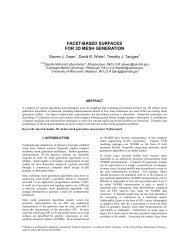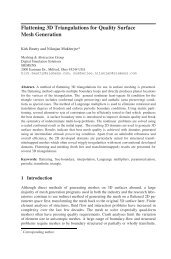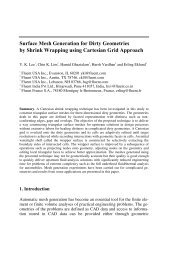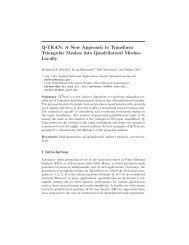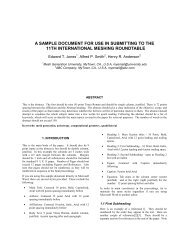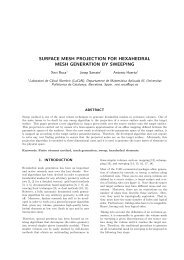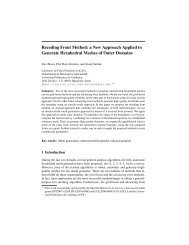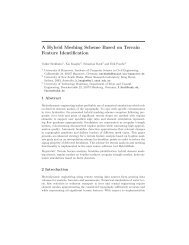Fitting Polynomial Surfaces to Triangular Meshes with Voronoi ...
Fitting Polynomial Surfaces to Triangular Meshes with Voronoi ...
Fitting Polynomial Surfaces to Triangular Meshes with Voronoi ...
Create successful ePaper yourself
Turn your PDF publications into a flip-book with our unique Google optimized e-Paper software.
4 Vincent Nivoliers, Dong-Ming Yan, and Bruno Lévy<br />
Methods based on point-<strong>to</strong>-point distances<br />
To remesh surfaces, “shrink-wrap” methods [5, 9] iteratively project the template<br />
on<strong>to</strong> the input mesh while minimizing a regularization criterion. A<br />
similar idea can be applied <strong>to</strong> subdivision surfaces [15, 16], using an exact<br />
algorithm <strong>to</strong> find closest points on the subdivision surface and the exact evaluation<br />
of the subdivision surface. The “dual domain relaxation” method [25]<br />
uses some variants of Laplace surface editing <strong>to</strong> fit a template <strong>to</strong> the input<br />
mesh. Since they are based on point-<strong>to</strong>-point distances, the methods above<br />
can mostly do small corrections on the geometry, and have difficulties converging<br />
when the initialization is far away from the target surface. In contrast,<br />
VSDM can successfully fit a control mesh <strong>to</strong> a surface.<br />
Squared distance minimization (SDM)<br />
SDM was proposed by Pottmann et al. [18] for curve and surface fitting. The<br />
SDM framework fits a surface S <strong>to</strong> an input mesh T by minimizing an approximation<br />
of the objective function E(X) :<br />
E(X) = F S→T (X) + λR(X)<br />
where:<br />
F S→T (X) = ∫ S(X) ‖ x − Π T (x) ‖ 2 dx<br />
R(X) = ‖LX‖ 2 (1)<br />
In this equation, X = [x i ]<br />
i=0 n denotes the coordinates that determine S and<br />
Π T (x) denotes the projection of x on<strong>to</strong> T , i.e. the point of T nearest <strong>to</strong> x. The<br />
term R(X) is a quadratic regularization energy and L a discretization of the<br />
Laplacian. The regularization fac<strong>to</strong>r λ lets the user choose a tradeoff between<br />
the smoothness of S and the fitting criterion.<br />
Wang et al. [23] showed that SDM can be characterized as a quasi-New<strong>to</strong>n<br />
method and they applied it <strong>to</strong> B-spline curve fitting. Cheng et al. [2, 3] proposed<br />
a subdivision surface fitting algorithm based on SDM. In the methods<br />
above, the approximation of the integral is based on both a point-sampling<br />
X = [x i ]<br />
i=1 n of S and a point-sampling Y = [y j] m j=0<br />
of T . The approximation<br />
has several variants that correspond <strong>to</strong> Taylor expansions of different orders<br />
(see Figure 2).<br />
The squared distance between x i and T can be replaced by :<br />
• Point Distance (PD): the squared distance <strong>to</strong> the nearest sample y j (order<br />
0 approximation);<br />
• Tangent Distance (TD): the squared distance <strong>to</strong> the nearest point on the<br />
tangent plane of the nearest sample (order 1 approximation);




